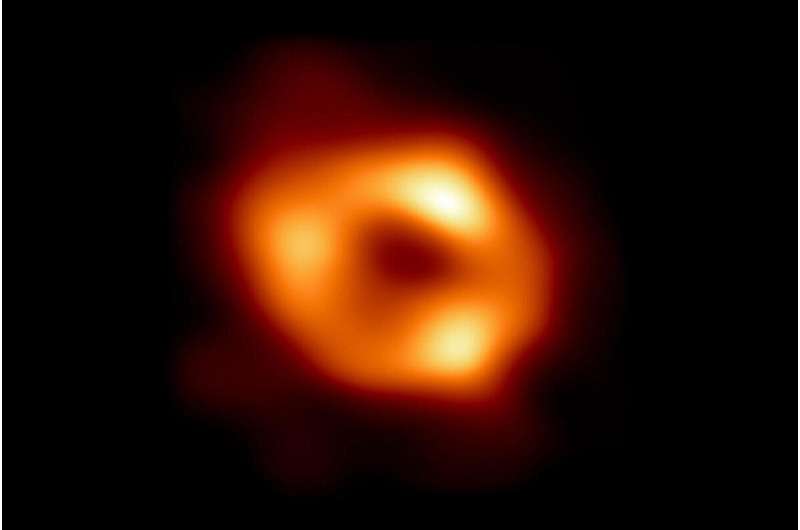This article has been reviewed according to Science X's editorial process and policies. Editors have highlighted the following attributes while ensuring the content's credibility:
fact-checked
peer-reviewed publication
trusted source
proofread
Massive merger: Study reveals evidence for origin of supermassive black hole at galaxy's center

The origins of aptly named supermassive black holes—which can weigh in at more than a million times the mass of the sun and reside in the center of most galaxies—remain one of the great mysteries of the cosmos.
Now, researchers from the Nevada Center for Astrophysics at UNLV (NCfA) have discovered compelling evidence suggesting that the supermassive black hole at the center of our Milky Way galaxy, known as Sagittarius A* (Sgr A*), is likely the result of a past cosmic merger.
The study, published Sept. 6 in the journal Nature Astronomy, builds on recent observations from the Event Horizon Telescope (EHT), which captured the first direct image of Sgr A* in 2022. The EHT, the result of a global research collaboration, syncs data from eight existing radio observatories worldwide to create a massive, Earth-sized virtual telescope.
UNLV astrophysicists Yihan Wang and Bing Zhang utilized the data from the EHT observation of Sgr A* to look for evidence on how it may have formed. Supermassive black holes are thought to grow either by the accretion of matter over time, or by the merger of two existing black holes.
The UNLV team investigated various growth models to understand the peculiar rapid spin and misalignment of Sgr A* relative to the Milky Way's angular momentum. The team demonstrated that these unusual characteristics are best explained by a major merger event involving Sgr A* and another supermassive black hole, likely from a satellite galaxy.
"This discovery paves the way for our understanding of how supermassive black holes grow and evolve," said Wang, the lead author of the study and an NCfA postdoctoral fellow at UNLV. "The misaligned high spin of Sgr A* indicates that it may have merged with another black hole, dramatically altering its amplitude and orientation of spin."
Using sophisticated simulations, the researchers modeled the impact of a merger, considering various scenarios that align with the observed spin properties of Sgr A*. Their results indicate that a 4:1 mass ratio merger with a highly inclined orbital configuration could reproduce the spin properties observed by the EHT.
"This merger likely occurred around 9 billion years ago, following the Milky Way's merger with the Gaia-Enceladus galaxy," said Zhang, a distinguished professor of physics and astronomy at UNLV and the founding director of the NCfA. "This event not only provides evidence of the hierarchical black hole merger theory but also provides insights into the dynamical history of our galaxy."
Sgr A* sits at the center of the galaxy more than 27,000 light years away from Earth, and sophisticated tools like the EHT provide direct imaging that helps scientists put predictive theories to the test.
Researchers say that the findings from the study will have significant implications for future observations with upcoming space-borne gravitational wave detectors, such as the Laser Interferometer Space Antenna (LISA), which is planned to launch in 2035 and is expected to detect similar supermassive black hole mergers across the universe.
More information: Yihan Wang et al, Evidence of a past merger of the Galactic Centre black hole, Nature Astronomy (2024). DOI: 10.1038/s41550-024-02358-w
Journal information: Nature Astronomy
Provided by University of Nevada, Las Vegas





















